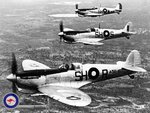- Thread starter
- #81
Because the air is already slowed down 20% by passing through the prop.
RG may I ask, how did you calculate that ??
Also wasnt the prop normally developed to 'cut' through the air, and 'accelerate' it backwards at an even faster rate =Thrust ?
(Your in deep now RG, and your about to sink
Not really. This was the belief in the pre-war years, when the blunt nose of a radial was simply stuck into the wind. But during WWII advancements in cowl and spinner design showed that radial designs could be just as streamlined as liquid cooled designs. Look at all the fastest props of WWII - except for the P-51H (which has significantly improved radiator thrust over the B/D), they are all radial type designs. Even the TA-152 is, for all intents and purposes, a radial type design.
Does this look like a Radial engine to you ?
Fw-190D-9 liquid-cooled inline engine.



